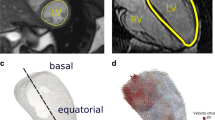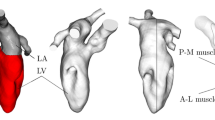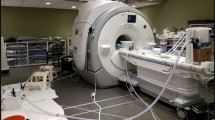Abstract
A three-dimensional computational fluid dynamics (CFD) method has been developed to simulate the flow in a pumping left ventricle. The proposed method uses magnetic resonance imaging (MRI) technology to provide a patient specific, time dependent geometry of the ventricle to be simulated. Standard clinical imaging procedures were used in this study. A two-dimensional time-dependent orifice representation of the heart valves was used. The location and size of the valves is estimated based on additional long axis images through the valves. A semi-automatic grid generator was created to generate the calculation grid. Since the time resolution of the MR scans does not fit the requirements of the CFD calculations a third order bezier approximation scheme was developed to realize a smooth wall boundary and grid movement. The calculation was performed by a Navier–Stokes solver using the arbitrary Lagrange–Euler (ALE) formulation. Results show that during diastole, blood flow through the mitral valve forms an asymmetric jet, leading to an asymmetric development of the initial vortex ring. These flow features are in reasonable agreement with in vivo measurements but also show an extremely high sensitivity to the boundary conditions imposed at the inflow. Changes in the atrial representation severely alter the resulting flow field. These shortcomings will have to be addressed in further studies, possibly by inclusion of the real atrial geometry, and imply additional requirements for the clinical imaging processes.











Similar content being viewed by others
References
Atkinson, D. J. and R. R. Edelman. Cineangiography of the heart in a single breath hold with a segmented turboflash sequence. Radiology 178:357–360, 1991.
Axel, L. Blood flow effects in magnetic resonance imaging. Am J Roentgenol 143(6):1157–1166, 1984.
Baccani, B., F. Domenichini, and Pedrizzetti. Vortex dynamics in a model left ventricle during filling. Eur. J. Mech. B/Fluids 21:527–543, 2002.
Baccani, B., F. Domenichini, and Pedrizzetti. Model and influence of mitral valve opening during the left ventricular filling. J. Biomech. 36:355–361, 2003.
Baccani, B., F. Domenichini, G. Pedrizzetti, and G. Tonti. Fluid dynamics of the left ventricular filling in dilated cardiomyopathy. J. Biomech. 35(5):665–671, 2002.
Bolzon, G., L. Zovatto, and G. Pedrizzetti. Birth of three-dimensionality in a pulsed jet through a circular orifice. J. Fluid. Mech. 493:209–218, 2003.
Chahboune, B. and J. M. Crolet. Numerical simulation of the blood-wall interaction in the human left ventricle. Eur. Phys. J.-Appl. Phys. 2:291–297, 1998.
Cheng, Y., H. Oertel, and T. Schenkel. Fluid–structure coupled cfd simulation of the left ventricular flow during filling phase. Ann. Biomed. Eng. 33(5):567–576, 2004.
Domenichini, F., G. Pedrizzetti, and B. Baccani. Three-dimensional filling flow into a model left ventricle. J. Fluid Mech. 539:179–198, 2005.
Ebbers, T, L. Wigstrï, A. F. Bolger, B. Wranne, M. Karlsson. Noninvasive measurement of time-varying three-dimensional relative pressure fields within the human heart. J. Biomech. Eng. 124:288–293, 2002.
Ferziger, J. and M. Peric. Computational Methods for Fluid Dynamics. Berlin: Springer, 1997.
Geiger, D., A. Gupta, L. A. Costa, and J. Vlontzos. Dynamic programming for detection, tracking and matching deformable contours. IEEE Trans. PAMI 17(3):294–302, 1995.
Hennig, J. K-space sampling strategies. Eur Radiol 9:1020–1031, 1999.
Hunter P. J., A. J. Pullan, B. H. Smaill. Modeling total heart function. Annu. Rev. Biomed. Eng. 5:147–177, 2003.
Jolly, M.-P. Combining edge, region and shape information to segment the left ventricle in cardiac mr images. In: MICCAI, 2001, pp. 482–490.
Kilner, P. J., G.-Z. Yang, A. J. Wilkes, M. R. H., D. N. Firmin, and M. H. Yacoub. Asymmetric redirection of flow through the heart. Nature 404:759–761, 2000.
Kim, W. Y., P. G. Walker, E. M. Pedersen, J. K. Poulsen, S. Oyre, K. Houlind, and A. P. Yoganathan. Left ventricular blood flow patterns in normal subjects: A quantitative analysis by three-dimensional magnetic resonance velocity mapping. JACC 26(1):224–238, 1995.
Lemmon, J. D. and A. P. Yoganathan. Computational modeling of left herat diastolic function: Examination of ventricluar dysfunction. J. Biomech. Eng. 122:297–303, 2000.
Lemmon, J. D. and A. P. Yoganathan. Three-dimensional computational model of left heart diastolic function with fluid–structure interaction. J. Biomech. Eng. 122:109–117, 2000.
Lima, J. A. and M. Y. Desai. Cardiovascular magnetic resonance imaging: current and emerging applications. J Am Coll Cardiol 44(6):1164–1171, 2004.
Long, Q., R. Merrifield, G. Z. Yang, X. Y. Xu, P. J. Kilner, and D. N. Firmin. The influence of inflow boundary conditions on intra left ventricle flow predictions. J. Biomech. Eng. 125:922–927, 2003.
Lorenz, C. H., E. S. Walker, V. L. Morgan, S. S. Klein, and T. P. Graham jr. Normal human right and left ventricular mass, systolic function, and gender differences by cine magnetic resonance imaging. Journal of Cardiovascular Magnetic Resonance 1:7–21, 1999.
McQueen, D. M. and C. Peskin. Shared-memory parallel vector implementation of the immersed boundary method for the computation of blood flow in the beating mammalian heart. J. Supercomput. 11(3):213–236, 1997.
McQueen D. M., C. Peskin. A three-dimensional computer model of the human heart for studying cardiac fluid dynamics. Comput. Graph. 34:56–60, 2000.
Mortensen, E. N., W. A. Barrett. Interactive segmentation with intelligent scissors. Graphical Models and Image Processing 60(5):349–384, 1998.
Nakamura, M., S. Wada, T. Mikami, A. Kitabatake, and T. Karino. Computational study on the evolution of an intraventricular vortical flow during early diastole for the interpretation of color m-mode doppler echocardiogramms. Biomech. Model. Mechanobiol. 2:59–72, 2003.
Nash, M. P. and P. J. Hunter. Computational mechanics of the heart: From tissue structure to ventricular function. J. Elast. 61(1/3):113–141, 2000.
Naujokat, E., and U. Kiencke. Neuronal and hormonal cardiac control processes in a model of the human circulatory system. Int. J. Bioelectromagn. 2(2), 2000.
Noble, D. Modelling the heart: from genes to cells to the whole organ. Science 295:1678–1682, 2002.
Pedrizzetti, G., and F. Domenichini. Nature optimizes the swirling flow in the human left ventricle. Phys. Rev. Lett. 95:108101, 2005.
Pelc, N. J., R. J. Herfkens, A. Shimakawa, and D. R. Enzmann. Phase contrast cine magnetic resonance imaging. Magn Reson Q 7(4):229–254, 1991.
Perktold, K., M. Prosi, and H. Florian. Computational models of arterial flow and mass transport. CISM Courses and Lectures (446):73–136, 2003.
Peskin, C. S., and D. M. McQueen. Fluid dynamics of the heart and its valves, case studies in mathematical modeling, In: Ecology, Physiology and Cell Biology. New Jersey: Pretice-Hall, 1996, pp. 309–337.
Rebergen, S. A., E. E. van der Wall, J. Doornbos, and A. de Roos. Magnetic resonance measurement of velocity and flow: technique, validation, and cardiovascular applications. Am Heart J 126(6):1439–1456, 1993.
Saber, N. R., A. D. Gosman, N. B. Wood, P. J. Kilner, C. L. Charrier, and D. N. Firmin. Computational flow modeling of the left ventricle based on in vivo mri data: Initial experience. Ann. Biomed. Eng. 29(4):275–283, 2001.
Saber, N. R., N. B. Wood, A. D. Gosman, R. D. Merrifield, G. Z. Yang, C. L. Charrier, P. D. Gatehouse, and D. N. Firmin. Progress towards patient-specific computational flow modeling of the left heart via combination of magnetic resonance imaging with computational fluid dynamics. Ann. Biomed. Eng. 31(1):42–52, 2003.
Schenk, A., G. Prause, and H. Peitgen. Local cost computation for efficient segmentation of 3d objects with live wire. In: Proceedings of SPIE, edited by M. Sonka and K. M. Hanson. SPIE, Vol. 4322, 2001, pp. 1357–1364.
Schoephoerster, R. T., C. L. Silva, and G. Ray. Evaluation of ventricular function based on simulated systolic flow dynamics computed from regional wall motion. J. Biomech. 27:125–136, 1994.
Stalling, D., and H.-C. Hege. Intelligent scissors for medical image segmentation. In: Tagungsband zum 4. Freiburger Workshop: Digitale Bildverarbeitung in der Medizin, edited by B. Arnolds, H. Mueller, T. Saupe, and D. Tolxdorf, 1996, pp. 32–36.
Taylor, T. W., H. Okino, and T. Yamaguchi. Three-dimensional analysis of left ventricular ejection using computational dynamics. J. Biomech. Eng. 116:127–130, 1994.
Vesier, C., J. D. Lemmon, R. A. Levine, and A. P. Yoganathan. A three-dimensional computational model of a thin-walled left ventricle. In: Proceedings on IEEE Supercomputing ’92, 16–20 November, 1992, pp. 73–82.
Vierendeels, J. A., K. Riemslagh, and E. Dick. Computer simulation of intraventricular flow and pressure gradients during diastole. J. Biomech. Eng. 122:667–674, 2000.
Vierendeels, J. A., K. Riemslagh, E. Dick, and P. Verdonck. Computer simulation of left ventricular filling flow. Comput. Cardiol. 26:177–180, 1999.
Watanabe, H., T. Hisada, S. Sugiura, J. Okada, and H. Fukunari. Computer simulation of blood flow, left ventricular wall motion and their interrelationship by fluid–structure interaction finite element method. JSME Int. J. Ser. C- Mech. Syst. Mach. Elem. Manufact. 45(4):1003–1012, 2002.
Watanabe, H., S. Sugiura, H. Kafuku, and T. Hisada. Multiphysics simulation of left ventricular filling dynamics using fluid–structure interaction finite element method. Biophysical J. 87:2074–2085, 2004.
Acknowledgments
The authors wish to thank all undergraduate, graduate and Ph.D. students that helped in developing the KaHMo. Especially we wish to thank Kathrin Spiegel who greatly simplified the tedious task of grid generation and Ron Schwarz from Fraunhofer FIT for the segmentation work.
Author information
Authors and Affiliations
Corresponding author
Rights and permissions
About this article
Cite this article
Schenkel, T., Malve, M., Reik, M. et al. MRI-Based CFD Analysis of Flow in a Human Left Ventricle: Methodology and Application to a Healthy Heart. Ann Biomed Eng 37, 503–515 (2009). https://doi.org/10.1007/s10439-008-9627-4
Received:
Accepted:
Published:
Issue Date:
DOI: https://doi.org/10.1007/s10439-008-9627-4




